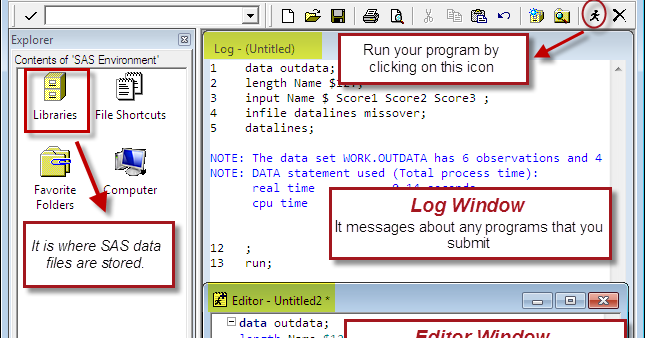
- #How to download sas program to excel code#
- #How to download sas program to excel free#
- #How to download sas program to excel windows#
It is either not an Excel spreadsheet or it is damaged.ĮRROR: Import unsuccessful. NOTE: DATA statement used (Total process time):Ĥ6 DATAFILE = out /* the downloaded copy */ĮRROR: Error opening XLSX file -> \sample1.xlsx.

NOTE: remote:/Test_excel.xlsx => local:C:\Users\jrozario\AppData\Local\Temp\SEG5496\SAS TemporaryĢ The SAS System 10:27 Thursday, September 14, 2017 I am connecting to UNIX SAS using FILENAME SFTP method, but I am getting the following issue: I am running my program from Desktop SAS.
#How to download sas program to excel code#
I am trying your mentioned code to move or copy an excel file from our SAS UNIX server to my local machine. However I am facing issues in the following scenario. For a specific example of this in action, see this tip about working with the Stored Process Web Application. In that case, you can use the reserved fileref _WEBOUT instead of the OUT fileref. Or, going the other way, perhaps you have a SAS stored process that creates a file that you want to position as a "download" file when the user runs the stored process in a web browser. MIXED=NO /* not supported for EXCELCS */ RUN GETNAMES=YES /* not supported for EXCELCS */
#How to download sas program to excel windows#
* Works on 32-bit Windows */ /* If using 64-bit SAS, you must use DBMS=EXCELCS */ PROC IMPORT OUT= WORK.test Here's an example that grabs an Excel file from the Web and imports it into SAS:įilename in url "" /* PROXY= is important for going outside firewall, if you have one */ /* proxy="" */ Simply use FILENAME URL to define the IN fileref. For example, imagine that there is a file on the Web that you want to bring into SAS for analysis. But the cool thing about the above program is that it can copy files to/from other places as well - any location that you can access with a FILENAME statement, including URLs. It's true that you can copy disk-based files from one place to another by using operating system shell commands ( via SYSTASK, for example).

* copy the file byte-for-byte */ data _null_ Anyway Strings are enclosed by " " so it should be fine./* these IN and OUT filerefs can point to anything */ filename in "c: \dataIn \input.xlsx" If you want to have " " as separator instead on "," use write.csv2(aux, "actual_file.csv"). Which will produce within the same folder with the original SAS file, the desired. For this you simply add below those lines from above the following: write.csv(aux, "actual_file.csv") csv file in order to have the final job done. Notice the NULL there, it has the purpose of converting empty strings to NULL.īut wait, we also need to convert it to a. After the installation you will have a tab with the preview of the data within the file and also the R script ran behind which will look like this: library(haven)Īux <- read_sas("//PATH_ON_YOUR_MACHINE_TO_FILE/actual_file.sas7bdat", NULL) It will ask you to import the haven library. Steps to follow in order to import the file using the RStudio "visual" way: Evironment tab -> Import Dataset -> From SAS. sas7bdat file opened, and then do the conversion step. You can use this as a starting point, in order to have the. Using it, you can open various formats of files and RStudio generates for you the R script it ran behind.
#How to download sas program to excel free#
I came across the same "need" and after some research here and there, I found a nice and easy way with R and the latest version of RStudio (as per 2020 June date - the FREE one).


 0 kommentar(er)
0 kommentar(er)
